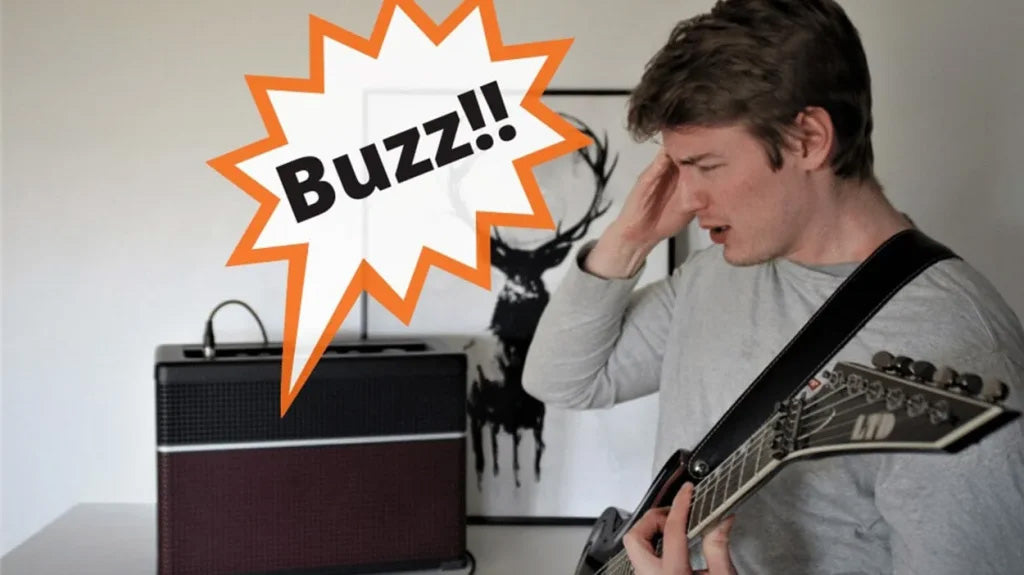Written by a Guitar Technician
Unwanted amp noise can quickly turn a great tone into a frustrating mess. Whether it’s a soft background hum or an aggressive buzz, that sound usually indicates an issue somewhere in your signal chain, power supply, or equipment setup.
As a professional guitar technician, I’ve diagnosed hundreds of noise complaints. In this article, I’ll walk you through the most common causes of amp hum or buzz, how to identify them, and what steps you can take to resolve them.
1. Ground Loop Hum
What it sounds like: A deep, steady hum (typically 60Hz in North America or 50Hz in other regions) that persists even when you're not playing.
What causes it:
A ground loop occurs when two or more pieces of audio gear are grounded through different paths but connected via signal cables. This creates a current loop that introduces hum.
Solutions:
- Plug all equipment (amp, pedals, audio interface) into the same power strip or power conditioner.
- Use an isolation transformer or ground loop isolator between your amp and other audio devices.
- Use a DI box with a ground lift switch for live or recording environments.
- Never remove the ground pin from a power plug. It creates a serious shock hazard.
2. Pickup Interference
What it sounds like: A buzzing noise that changes or gets louder depending on your guitar's orientation in the room.
What causes it:
Single-coil pickups are highly sensitive to electromagnetic interference (EMI). They can pick up noise from light dimmers, monitors, computers, power supplies, and even your amp's internal transformer.
Solutions:
- Rotate or reposition your guitar while playing to minimize interference.
- Turn off or move away from noisy electronic devices (LED lights, Wi-Fi routers, televisions).
- Add shielding to your guitar’s electronics cavity using copper foil or conductive paint.
- Consider replacing your pickups with noiseless or hum-cancelling alternatives.
3. Dirty or Inconsistent Power
What it sounds like: A general buzz or background noise that may fluctuate or worsen during specific times of day.
What causes it:
Power outlets in older buildings or shared circuits can carry electrical noise from appliances, HVAC systems, or dimmer switches. This interference is transmitted through your amp's power cable.
Solutions:
- Use a high-quality power conditioner to clean incoming power.
- Try different outlets in the room, especially those on separate circuits.
- Use a voltage regulator in areas with known power fluctuation issues.
- Avoid plugging into power strips shared with appliances or office equipment.
4. Tube-Related Issues (For Tube Amps)
What it sounds like: A hum that increases in volume over time or a crackling buzz when playing, especially under gain.
What causes it:
- Aging or faulty preamp/power tubes.
- Poor tube-to-socket contact.
- Unbalanced phase inverter circuit.
- Failing capacitors in the amp’s power section.
Solutions:
- Turn off the amp, let tubes cool, and inspect for discoloration or low glow.
- Tap each tube lightly with a wooden stick. A loud ringing sound suggests a microphonic tube.
- Replace microphonic or weak tubes with high-quality, matched replacements.
- Have a technician properly bias the amp if you change the power tubes.
- If the hum remains, the amp may need internal servicing or capacitor replacement.
5. Cable Issues
What it sounds like: Intermittent buzzing or popping, often triggered by moving the guitar, cables, or touching input jacks.
What causes it:
Low-quality or worn-out cables, poor shielding, oxidized plugs, or loose jacks can introduce high-frequency noise into your signal path.
Solutions:
- Replace instrument and patch cables with shielded, high-quality options.
- Clean cable ends and jack contacts using contact cleaner.
- Check for tight connections on all pedal and amp input/output jacks.
- Avoid using coiled instrument cables or cheap daisy chains unless properly isolated.
6. Pedal Power Problems
What it sounds like: Buzzing or whine introduced when pedals are turned on. Sometimes the noise increases with more pedals connected.
What causes it:
Daisy-chaining multiple pedals with a non-isolated power supply can create grounding issues or allow interference between pedals. Digital pedals are particularly prone to creating high-frequency noise when powered poorly.
Solutions:
- Use an isolated power supply for your pedalboard. Each output should be fully isolated.
- Power digital pedals (loopers, reverbs, delays) from dedicated outputs.
- Test pedals individually to find out if one is creating the noise.
- Avoid mixing analog and digital pedals on the same daisy chain.
7. Faulty or Aging Amplifier Components
What it sounds like: Persistent hum or buzzing that exists even with nothing plugged into the amp.
What causes it:
- Faulty internal grounding.
- Aging electrolytic filter capacitors.
- Transformer noise.
- Poor layout shielding in vintage or budget amps.
Solutions:
- Disconnect all cables and test the amp on its own. If hum remains, the issue is internal.
- Bring the amp to a certified technician for a full inspection.
- If the amp is vintage, consider having it recapped and serviced.
- Avoid DIY repairs on tube amps; internal voltages can be lethal.
8. Environmental Interference
What it sounds like: Noise that changes depending on where you’re located or what time of day you’re playing.
What causes it:
Electrical interference from nearby sources such as wireless routers, dimmer switches, ceiling fans, fluorescent ballasts, or neighboring electrical panels.
Solutions:
- Test your amp in a different room or building to rule out location-based interference.
- Turn off nearby electronics and fluorescent lighting.
- Use ferrite chokes on power cables to reduce EMI pickup.
- Install shielding in walls if interference is consistent and unavoidable.
Troubleshooting Checklist
| Symptom | Most Likely Cause |
|---|---|
| Hum with no guitar plugged in | Internal amp issue or ground loop |
| Buzzing only with guitar plugged | Pickup or cable interference |
| Noise changes as you move | EMI picked up by pickups |
| Constant 60Hz hum | Ground loop or power line noise |
| Crackle or pop when moving cable | Bad cable or loose jack |
| Whining from pedalboard | Poor pedal power supply isolation |
Conclusion
Buzzing and humming can come from many sources, but each one can be isolated and resolved through a systematic approach. If you're dealing with noise, always start simple: unplug everything and rebuild your rig one cable or component at a time.
If you're still not sure where the problem lies, it may be time to bring your amp or guitar into a qualified technician. Professional diagnosis not only solves the issue faster — it prevents long-term damage and gets you back to what matters: playing.
Need help identifying amp noise?
We offer expert diagnostics, pickup shielding services, cable testing, and amplifier maintenance.
Contact us or book a bench appointment today. - 0189094640

